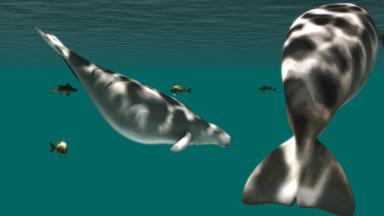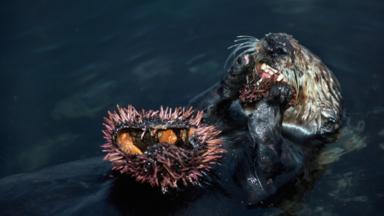The huge and extraordinary Steller's sea cow was ten metres long
Not so long ago, a sailor navigating the cold waters of the northern Pacific Ocean might have had every chance of been confronted by a giant cow.
This cow would have measured 10 metres long, and weighed between five and ten tonnes.
And it would have been the most adept swimmer, spending its days cruising the seas, grazing on fields of grass growing underwater.
The cow in question was known as Steller’s sea cow. It is now extinct, having left this earth almost 250 years ago.
But many people are unaware that such a huge and extraordinary creature once existed, or know its incredible story.
And even today, scientists are still discovering fundamental insights into the life and history of this huge, lumbering, but almost mystical animal.
Steller’s sea cow was much, much bigger
Steller’s sea cow didn’t look anything like the modern cows we rear for meat and milk.
It belonged to a different group of mammals, known as the Sirenia, named after the mermaids of Greek mythology that were known as sirens.
Today, four species of Sirenia still exist, grouped into two distinct families.
One, the dugong (Dugong dugon) of south-east Asia, measures some 3 metres long, weighing around 400 kg.
There are also three species of manatee; the Amazonian manatee (Trichechus inunguis), the West Indian manatee (Trichechus manatus), and the West African manatee (Trichechus senegalensis). These can grow to 4 metres long and weigh almost 600 kg, and the three species of manatee are more closely related to each other than the dugong.
All have large rotund bodies, downturned snouts, short rounded paddle-like flippers, and a horizontal tail fluke that they use to move around.
Hunters may have killed seven times as many sea cows as they could eat
But Steller’s sea cow (Hydrodamalis gigas) was much, much bigger. It reached a length of 10 metres and different sources suggest it could have weighed anywhere between 4,000-11,000 kgs.
It also lacked teeth, surviving by using a pair of broad horny pads to chew kelp.
Surprisingly perhaps, the first recorded sighting of a Steller’s sea cow didn’t happen until 1741, when a sailing expedition led by Captain Vitus Bering of the Russian Navy was marooned on an desolate, treeless uninhabited island, later named Bering Island, in what is today known as the Bering Sea.
The sailors survived by hunting and eating the huge sea cow.
They documented its habits and number, with estimates suggesting that perhaps 1500 or fewer lived around the island.
The dugong now survives as the only truly herbivorous marine mammal
Like its modern relatives, the sea cow aggregated in herds. That and its slow-moving, almost docile behaviour made it easy prey.
The sea cow was studied by a single scientist, Georg Steller, after whom the species is named.
Steller described the sea cow’s 3 to 4-inch thick blubber as tasting something like almond oil, which might have played an unfortunate role in its demise.
Those sailors that escaped Bering Island spread word of the bounty of meat to be found off its shores. Each year new expeditions hunted the animals.
One report stated that one sea cow could feed 33 men for a month, and it was thought sailors stored the meat on ships to feed themselves on voyages lasting up to a year.
Earlier in their history, the first sirenians may have been hippo-sized
Incredibly, the last sea cow was reported killed in 1768, just 27 years after the island and species had been discovered by modern man.
Scientists have since tried to establish whether these hunting expeditions killed off the sea cow, or whether other factors played a role.
One idea is that humans also hunted sea otters on the island. These otters fed on sea urchins, and the otters' absence caused an explosion in sea urchin numbers.
This plague of sea urchins then ate all the shallow kelp on the sea floor, removing the main food source of Steller’s sea cow, essentially starving the population to death.
But studies now suggest this was unlikely and humans did hunt the sea cows far faster than they could reproduce. Hunters may have even killed seven times as many sea cows as they could eat, using wasteful primitive hunting methods, assuming there was an almost infinite supply.
As a result humans drove Steller’s sea cow extinct within three decades.
That makes Steller’s sea cow one of the few truly large mammals known to have been driven extinct in the modern age.
Sirenians are also special as they are one of only two major groups of mammals to have evolved an aquatic lifestyle that allowed them to colonise the oceans.
Whales aside, the gargantuan Steller’s sea cow may have been the largest mammal to live in the modern age
A new genetic analysis, published in the journal Molecular Phylogenetics and Evolution, has now established which animal still living today is the closest relative of the Steller's sea cow.
A survey of the genes held in the nucleus of the animals’ cells confirms that dugongs, rather than manatees, are more closely related to Steller's sea cows.
The dugong now survives as the only truly herbivorous








No comments:
Post a Comment